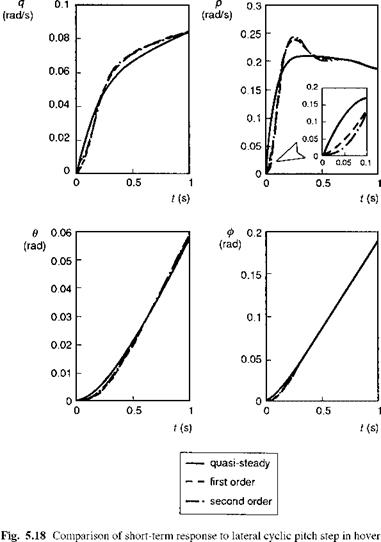Step responses in hover – effect of key rotor parameters
Two of the fundamental rotor parameters affecting helicopter angular motion are the effective flap stiffness, reflected in the flap frequency ratio kp, and the rotor Lock

number у, given by
The effects of these parameters on helicopter stability have already been discussed in Chapter 4, and in Chapter 2 we briefly examined the effects on dynamic response. Figures 5.19 and 5.20 compare responses to step lateral cyclic inputs for the Bol05 in hover with varying Xe and y respectively, across ranges of values found in current operational helicopters. The effect of rotor flapping stiffness is felt primarily in the short term. The initial angular acceleration decreases and the time to reach maximum roll rate increases as the hub stiffness is reduced. On the other hand, the rate sensitivity
|
|
is practically the same for all three rotors. It is also apparent that the influence of the regressing flap mode on the short-term response is reduced as the rotor stiffness decreases. To achieve an equivalent attitude response for the standard Bo105 in the first second with the two softer rotors would require larger inputs with more complex shapes. The stiffer rotor can be described as giving a more agile response requiring a simpler control strategy, a point already highlighted in Section 5.2.2. One of the negative aspects of rotor stiffness is the much stronger cross-coupling, also observed in Fig. 5.19. The strong effects of control and rate coupling (see derivatives Me1c and Mp in Chapter 4) can be seen in the pitch response of the standard Bo105 rotor configuration. The ratio of pitch attitude excursions for the three rotors after only 2 s is 7:4:1. Cross-coupling must be compensated for by the pilot, a task that clearly adds to the workload. We shall examine another negative aspect of stiff rotors later, degraded pitch stability. As always, the optimum rotor stiffness will depend on the application, but with active flight control augmentation most of the negative effects of stiffer rotors can be virtually eliminated.
The selection of rotor Lock number is also application dependent, and the results in Fig. 5.20 illustrate the principal effects in the hover; in the cases shown, the Lock number was varied by changing the rotor blade inertia with compensating changes to rotor stiffness (Kв in eqn 5.65) to maintain constant kp. Roll control sensitivity (i. e., initial acceleration) is unaffected by Lock number, i. e., all three rotors flap by the same amount following the application of cyclic (actually the same happens for the three
|
|
rotors of different stiffness, but in those cases the hub moments are also scaled by the stiffness). The major effect of Lock number is to change the rate sensitivity, the lighter blades associated with the higher values of у resulting in lower values of gyroscopic damping retarding the hub control moment. The lower damping also increases the attitude response time constant as shown. Lock number also has a significant effect on cross-coupling as illustrated by the pitch response in Fig. 5.20.













